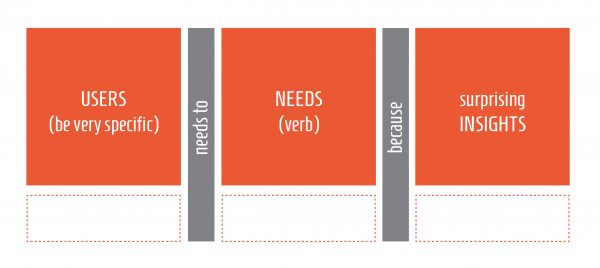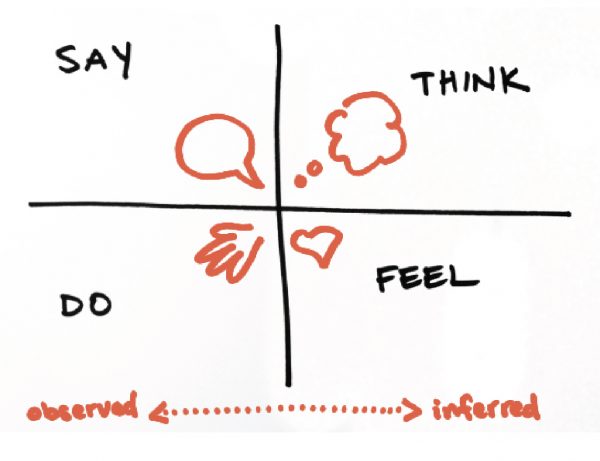Welcome to part 4 of a series about design thinking in strategy development. (If you are just joining, I encourage you to start at the beginning and read part 1 here.)
“If I had an hour to solve a problem I’d spend 55 minutes thinking about the problem and five minutes thinking about solutions.” – Albert Einstein
It’s time to turn the data you gained from interviews and observations into creating your organization’s point of view (POV). Why are clear and concise POVs important? They help you tell the customer story, plus increase alignment and understanding across your organization.
How to Create Your POV
A good POV will allow you to ideate and solve your challenge in a goal-oriented manner – keeping the focus on your users, their needs and your insights about them. Here’s an easy formula to keep in mind (courtesy of IDEO’s D School):

Note: you may come up with multiple POVs depending on the insights you gained during your earlier interviews.

It looks a bit like a Mad Lib, right? Actually, there is a Mad Lib method that I’ll discuss later in this post, but for now, let’s dive into the steps for creating a POV statement.
Step 1: Identify Users, Needs & Insights
There are three key components that make up the POV statement:
- User: Defines the type of specific user whom you’re writing your POV about.
- Need: Identifies the users’ essential needs/goals.
- Surprising Insight: Synthesizes the gathered information into a key takeaway. This statement can be used to design a solution.
Step 2: Create Your Chart
Place your scenario into a template like the example below. This creates a guide for structuring your POV statement.

Step 3: Form Your POV Statement
Mad Lib time! This is the fun part where you combine your user, needs and insight into a concise POV statement. If necessary, condense your statements to create a good story.
Example: A financial advisor needs a way to have meaningful conversations with more clients because business grows through genuine conversation with clients – not through paperwork.
More Tips for Your POV Statements
- Keep the focus narrow.
- Frame the challenge as a problem statement.
- Use them to evaluate competing ideas.
- Make them actionable.
- Remember, these statements will guide your innovation efforts and provide inspiration for your team.
After you have formed your POV statements, reframe them to “How might we … ?” (HMW) questions. Consider our earlier financial advisor example. Some questions could be:
- How might we speed up the time the advisor spends with clients?
- How might we increase the amount of meaningful conversations the advisor has?
- In what ways might we reduce the time it takes to do paperwork?
- How might we make doing paperwork more profitable for the advisor?
Did you notice that none of those statements provides a solution? This is intentional. Use these questions to begin brainstorming as a team. The key is allowing room to explore solutions. You can even expand into “What would happen if …” or “What is stopping us from …” once the team is comfortable. When the questions are complete, consolidate them into a list for the next meeting – your ideation session.
More Pre-Work for Your Ideation Session
We began this section by jumping right into developing a POV statement. But before you have your ideation session, I want to share a few more tools and tips to synthesize the data you’ve collected up thus far (thanks to Stanford D.School Bootleg):
Method #1: Use Empathy Maps to Gain Insights
An empathy map is useful for defining a customer, as well as identifying needs and insights. It’s best to use after you’ve completed observation sessions with your users.
- Draw it out. On a whiteboard or paper, draw and label four quadrants like so:

- Say: Write direct quotes from your customers.
- Do: What actions or behaviors did you observe?
- Think: What might your user be thinking? What does this tell you about their beliefs?
- Feel: What emotions might your subjects be feeling?
Note: Since feelings, thoughts, and beliefs cannot be directly observed, infer those by carefully paying attention to clues.
- Write down needs. “Needs” are emotional or physical necessities. They are activities and desires, not solutions. Identify needs from traits or from contradictions – such as a disconnect between what he/she says and does. Write them down on the side of your empathy map.
- Write down insights. An “insight” is a remarkable realization that you could leverage to better respond to a challenge. Insights often grow from contradictions between two user attributes (either within a quadrant or from two different quadrants) or from asking yourself “Why?” when you notice strange behavior. Write down potential insights on the side of your map. Capture tensions and contradictions as you work.
There is also a really good template of an empathy map developed by XPLANE, which is a bit more detailed. You can download a PDF here.
Method #2: Download & Synthesize
- Record to remember. Take good notes! Better yet, use a scribe AND record each interview session. That way you can go back and review the session with notes and capture stuff that may have been missed.
- Don’t wait to download. When you complete interviews, “download” or summarize the info as soon as possible while conversations are still fresh in your mind.
- Gather important quotes. Grab a bunch of Post-It notes and Sharpies. Begin by pulling out any quotes or notes that you feel are important. Write each note or quote on an individual Post-It, including the name of the user or activity. You can use multiple Post-It colors to represent similar items, e.g., quotes can be green and actions blue.
This can be done as a smaller team or with just the scribe and the interviewer. (And if you’re in a download session but weren’t at the original interview, ask questions. Try to get a feel for what the interview was like.)
- Identify themes. Call the strategy team together and start the process of synthesizing all of the interviews to identify themes and patterns. It’s ok if everything isn’t clear at first. As you go through this process, you’ll see a clearer picture.
- Define a clear journey. Each interview team should present their findings to the larger group. Place the sticky notes on the wall, and merge similar themes together. Remember, the goal is to reach a consensus within the group and define a clear journey for the data.
- Refine your customer insights. Once each group or team has “downloaded,” focus on insights to get a clearer view of the customer and help identify the problem. For each theme, start out with a high-level statement that describes the message.
Example theme: The line worker is often waiting for products to box.
Perhaps in interviews, many people said they were always waiting. As a group, you should collectively drill down on the cause. Ask “Why?” In fact, a good rule of thumb is to ask “Why?” five times. This will help get to the root of the problem.
Example insight: Line workers are waiting because the machine ahead of them jams when building the box.
We better understand what one of the problems may be. This is also much more actionable. When it comes to insights, they should be common across different research activities. Through interviews and observation, themes should be consistent and support each other. In the example above, we learned line workers are often waiting, and during observation, we noted the machine ahead of them jams a lot.
Of course, there is a wide range of methods for synthesizing data. Try different methods and see what works best for your organization. A few years ago I came across a book called Gamestorming: A Playbook for Innovators, Rulebreakers, and Changemakers. If you want to build on your playbook of different activities, I highly recommend you try it. You can also view a lot of activities on their website.
Up Next: Developing Solutions
Part 5 will cover ideation – the time for developing solutions. It’s the stage that most people associate with design thinking and will likely be the most uncomfortable – or the most enjoyable – part of the process. Check back soon, and if you have questions, just ask.

